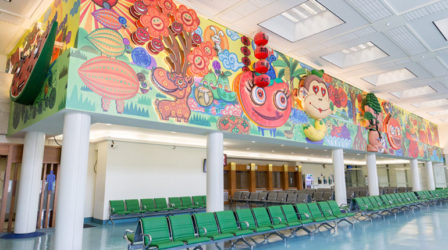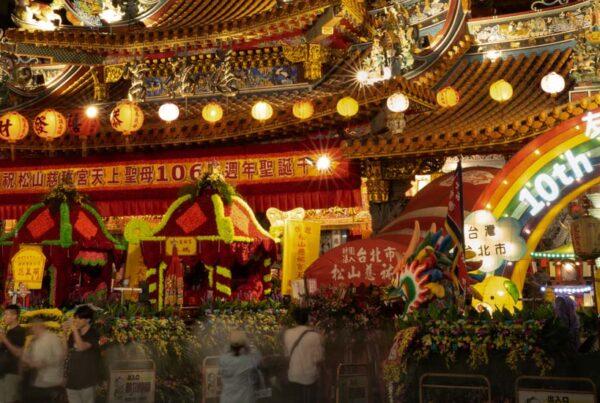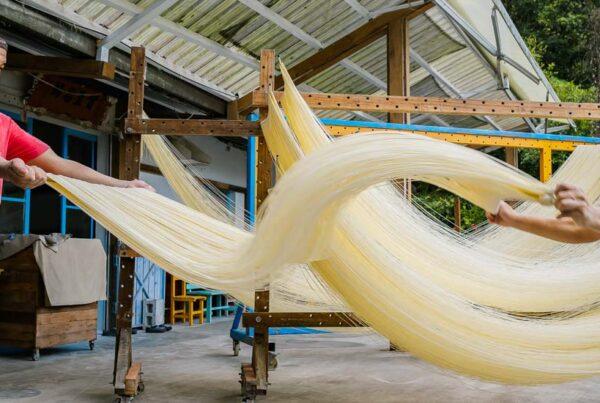
Painted wall in Kengkou Village
Imagine. You are flying into Taiwan and are going to have a layover of like three or fours hours at Taoyuan Airport (Taiwan Taoyuan International Airport to be exact; www.taoyuan-airport.com), the island’s main gateway. It’s not enough time to make it to Taipei City and back (there is a actually a free-tour bus service to the city and also to the Sanxia/Yingge area, available in the afternoon and in the morning, respectively (check out eng.taiwan.net.tw/tour/index.htm).
Now, you could hang out in a lounge or get a massage and while the time away. You could, however also go for a walk, in the rural countryside! Thanks to the new MRT Taoyuan Airport Line (www.tymetro.com.tw), in operation since earlier this year, not only has getting to Taipei become quicker and more convenient, exploring the places between the airport and the capital has become an interesting option too.
You probably haven’t heard of Kengkou Village (坑口村) in Taoyuan; most people in Taiwan don’t know this small village northwest of Taoyuan Airport either. But since the new metro line has a Kengtou Station, the first station after departing Terminal 1 for Taipei, people are now noticing the name and might be thinking of getting off the train and have a look around.
The village and it’s surroundings don’t qualify as a major tourist attraction by any stretch of the imagination, but it’s a great place to get a glimpse of rural Taiwan and go for a walk. To get to Kengtou, you need to take a Commuter Train headed for Taipei, which stops at all stations along the way (the Express Train only stops at a few stations, Kengtou not being one of it). The ride takes about 5 minutes and costs NT$30 (about US$1) on way.

The pace of life in Kengkou is slow
After leaving the station, you’ll be in rural Taiwan, you’ll spot flower fields and rice fields and older two-story houses. Head to the main road you can see from the station’s exit. There is a brown sign in Chinese directing you to “Kengkou Painted Village” (坑口彩繪村) and Chengsheng Temple (誠聖宮). Turn right and follow this road; watch out for cars and small trucks on this side-walk less country road.

The signs point to Kengkou Painted Village and Chengsheng Temple
There are very green (end of May) rice fields on both sides of the road, there might be dogs barking behind fences and birds chirping in the trees and on the power line along the road. You would expect the airplanes landing and taking off at the not-to-far-away airport affecting this peaceful setting, but they are far enough away to be not noticeable.

Very green rice fields in May

Young rice plants

There is no sidewalk, watch out for cars and trucks
After about 10 minutes of walking along the road, you’ll see a playground with animal sculptures on your right, then a parking lot with pig sculptures, and on your left a typical Taiwanese temple.

Playground with a zebra

Pigs at a car park
This traditional place of worship, Chengsheng Temple, is dedicated to the god Guansheng Dijun (關聖帝君), also known as the God of War. It was first built more than a century ago, and received a major face-lift in 2004. Inside you can see fine examples of Taiwanese temple architecture, including stone and wood carvings and very old statues of deities.

Kengkou’s Chengsheng Temple
After visiting the temple, take the street to the left (when facing the temple) and you’ll soon come to a cluster of houses with painted walls. This is the reason why the village is called “painted village.” Among the large and small wall paintings are those depicting rural scenes and farm life during the 1950s and 60s, a traditional kitchen, farm animals, and more.

Painted houses in Kengkou Village

Rural life in the 1950’s and 60’s

A traditional kitchen

The old way of doing the laundry

Farmer with traditional hat
The paint on the walls, subjected to strong sunshine in the hot summers, have started to fade, but they definitely give this small village something to make it special.

Village scene

Cranes?
There are also a number of animal statues; goats, water buffalo, pandas (!)…

A goat

Water buffalo

There are no real pandas in Taiwan… (except for the zoo)
And, because this is Taiwan where people love to mix things that “cannot be mixed” (example: traditional temple processions with blasting techno music), there is also a wall with two Minions and one, probably the best for taking pictures, with two large dinosaurs.

Minions

Dinosaurs
Walking around the village and taking pictures of the murals takes just 15 minutes, the village is not that big… But, you get a good idea of what rural life in Taiwan is like. It’s slow-paced, it’s old, it’s friendly old people tending to their gardens, it’s the smell of incense in an old temple…
After zipping back to Taoyuan Airport you’ll realize how much of a contrast there is between this small, quaint village and the modern buzzing airport.

Welcome to Kengkou, a village close to Taoyuan Airport![google_maps id=”6835″]
Taoyuan Airport is modern and has a lot of interesting facilities:
Text and photos by Twelli
About the author

Twelli
Long-time resident of Taiwan, Twelli likes to go on trips around Taiwan and make videos.
















